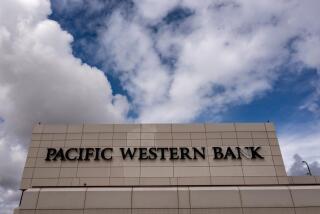Interstate Bank Deals: Rhetoric and Reality
Interstate banking is the answer. What is the question? How do federal bank regulators hope to cope with the fact that there have been more bank failures in the last two years than at any time since the Depression?
The regulators--the Federal Reserve and the Federal Deposit Insurance Corp.--gave their answer last Thursday when they sent to Senate Banking Committee Chairman Jake Garn (R-Utah) proposals for legislation that would ease restrictions on bank mergers across state lines. Hearings begin Thursday. With some banks in the Midwestern farm regions and the Southwestern oil regions clearly in trouble, Congress won’t dally in its consideration.
The regulators’ aim is to have legislation in force that would allow big-city banks to rescue failing local banks, sparing the government the trouble of doing it directly, as it had to in the case of Continental Illinois in 1984. The regulators have already asked banks such as California’s First Interstate Bancorp to take a look at troubled banks in Texas.
Euphoria and Gloom
What can we expect? Euphoria and gloom. The big banks will hail eased restrictions as opening the way for them to grow rapidly by acquiring at will among the 14,000 banks in the fragmented U.S. system. The smaller banks will paint dark pictures of national giants ignoring the needs of local communities.
Reality is more complex and less dramatic. First, we are not about to see all of our banking taken over by a handful of giant institutions--nor should we want such a thing.
Second, the legal structure that bars banks in one state from taking deposits in another is, beyond argument, an anachronism in a day when money-market funds take deposits by mail and toll-free telephone numbers. Consolidation is coming. But local banks, some of them quite small, will continue to enjoy a good business.
Third, and probably most significant, interstate banking will further enhance the role of the federal government in our financial system. In recent years, that role has increased, not diminished, despite all the talk of deregulation. The government became the insurer of first, and last, resort. The law, as we know, guarantees FDIC insurance for deposits up to $100,000.
But, in case after case in recent years, from the silver-happy Hunt brothers in 1980 to Continental Illinois, the government has demonstrated that when it comes to the crunch, it insures all deposits, large and small, foreign and domestic, lest a default imperil the national/international financial system.
Fed Picks and Chooses
Now, Washington takes on a new role as interstate banking licensor. The Federal Reserve will pick and choose who gets to buy what bank and where. It will base its choices on how adequate are the capital levels of the acquiring bank. So the big will get bigger only slowly.
And that is healthy, for as we learned from the dinosaurs, size is no guarantee of brains. The nation’s largest banks compiled quite a record of misguided enthusiasms in the last decade or so--from real estate investment trusts in the early 1970s to developing country loans in the late ‘70s. In fact, if you look at the profitability of banking institutions from large to medium to small, you often find an inverted pyramid with smaller organizations more profitable and efficient than the giants.
More pertinent, efficient local banks can thrive, not merely survive, in the new interstate environment. The reason is that the local bank--whether independent or a branch of a larger institution--has what the whole financial services industry is after these days: access to the consumer for checking and small savings accounts. Half a decade after interest rate deregulation, these are still the most stable, lowest-cost deposits a bank can have. Why do you think Citicorp’s visionary Walter Wriston and his successor John Reed made consumer deposits the focus of their giant institution?
But if small banks are so good, how come we had 129 bank failures last year? The quick answer, of course, is declines in agriculture and energy. But not all banks got in trouble. Those who did usually were overenthusiastic about lending against rising land prices or rising oil prices. When both fell, so did the banks.
What’s ahead? We may very well see New York-based Citicorp, which already has edged its operations into California, Florida, Illinois, Nevada and Arizona, get a foothold in Texas, the state that ranks third (behind New York and California) in bank deposits. But it is unlikely that local bankers will expire from the competition. We will continue to bank at institutions large and small. And the federal government’s role will continue to grow, for, as they say, he who pays the piper calls the tune.
More to Read
Sign up for Essential California
The most important California stories and recommendations in your inbox every morning.
You may occasionally receive promotional content from the Los Angeles Times.










